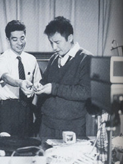From 1974-1993 WGBH Boston's 'New Television Workshop' supported the creation and broadcast of works for television by an extensive and illustrious group of artists. Nam June Paik not only created a number of his influential videos there, including '9/23/69 Experiment with David Atwood' (who was a WGBH engineer), but also with Japanese engineer Shuya Abe he created the Paik-Abe Video Synthesizer--a major development not only for Paik's work but for the entire medium. Other artists to pass through the workshop included Marina Abramovic, Laurie Anderson, Peter Campus, Stan Vanderbeek, and Bill Viola. Following in the footsteps of this important program is the WGBH Lab, which provides tools and broadcast access for a new generation of media artists. They offer a 'Filmmaker in Residence' program as well as the 'Sandbox' service that gives users free access to WGBH stock footage. For their new program, 'Open Call,' WGBH is teaming up with the National Black Programming Consortium, inviting 'pitches' from filmmakers and new media artists for projects which address current and historical issue of race in creative and relevant ways. Encouraging alternative approaches to narrative and broadcast, 'Open Call' and the WGBH Lab are progressively engaging in a multitude of issues relevant in contemporary media production and reception. These efforts are a timely and welcome reminder of the supportive potential of the Public Broadcasting System, and that public television isn't solely for the historical films of Ken Burns, but is also relevant to the diverse range media makers and issues of the present. - Caitlin Jones
